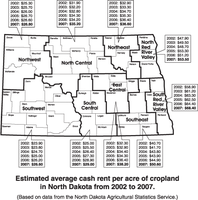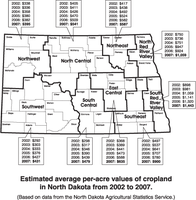North Dakota Cropland Values Continue Rapid Increase
(Click an image below to view a high-resolution image that can be downloaded)
A recent survey indicates that North Dakota cropland values continue to push higher, but at a slower rate. The increase was 8 percent during 2006 (from January 2006 to January 2007). This follows increases of 10 percent during 2005 and 11 percent during 2004. Land prices have been increasing roughly $50 per acre for the past four years, going from $460 per acre to more than $660. That beats the previous high of about $530 per acre in 1981.
""Although last year's increase indicates a very strong land market, it is the second consecutive year that values have not increased at an accelerating rate,"" says Andrew Swenson, North Dakota State University Extension Service farm and family resource management specialist. ""Cropland rents increased at a much lower rate than for farmland, but it was the first time since 1993 that rents increased by more than 4 percent."
Swenson bases his calculations on surveys conducted in January by the North Dakota Agricultural Statistics Service.
""Looking at historic data, one could make the argument either way about the future direction of land values,"" Swenson says. ""Land values are at record highs and the rent-to-land value ratio is currently at the low end at 6.1 percent, which occurred when land peaked in 1981.""
What happened after 1981? Land plummeted 40 percent during a six-year period from 1981 through 1987.
""Conversely, it could be argued that the rent-to-land value ratio could return to more historic norms by rents rising, not land falling,"" Swenson says. ""Also, in today's dollars after adjusting for inflation, the 1981 crop land value equates to about $1,200 per acre, which is far above current land values.""
Those who have preached caution during the past few years about purchasing land because of escalating values have been wrong up to this point. But Swenson notes that the price of anything, including land, doesn't increase forever. There are many factors that influence the demand for land, such as interest rates, health of the economy, farm policy and section 1031 exchanges. However, the major reason is the profit the land can produce. Swenson's best guess is that land values, after the strong runup in values, may become more sensitive to year-to-year farm profit.
Production costs were at record highs in 2005, but moved higher in 2006 and will be even higher in 2007. Producers have more dollars invested in a crop than ever before. There is risk of substantial financial loss if there is a hiccup in yields and/or crop prices. This was evident in 2006. Regions with the strongest profit had the strongest increase in land values. The southeast and northern Red River Valley were up 15 percent to $900 and $1,059 per acre, respectively. The southern Red River Valley was up more than 9 percent to $1,443 per acre. In the southwest, where profit was abysmal, the increase in land value only was 1 percent, to $431.
Somewhat surprising was the 6 percent to 9 percent increase in cropland value in the north-central, east-central and south-central regions to $541, $635 and $479 per acre, respectively. All of these regions were impacted, to varying degrees, by drought in 2006. Per-acre cropland values increased 3 percent in the northwest, to $395, and 1 percent, to $587, in the northeastern region.
Per-acre cropland rents increased very modestly by only 0.5 percent to 1.5 percent in the south-central, northeastern, northwestern and southwestern regions to $29, $36.60, $26.80 and $26.60, respectively. The north-central region had a 3 percent increase to $35.20. Rents increased 5 percent to 6 percent in the northern Red River Valley, east-central and southern Red River Valley to $53.50, $38.20 and $68.40, respectively. The largest rate of increase, 13 percent, occurred in the southeastern region,to $50.60.
""Land value prices have been increasing more in the southern half of the state, particularly in the areas that are more suited for soybean and corn production,"" Swenson says. ""Soybeans are the major reason, but there is increasing interest in corn. The per-acre increase in land values from 2002 to 2007 ranged from 81 percent, $497 to $900 per acre, in the southeast to 48 percent, $292 to $431, in the southwest.
""Increases in the northern half of the state from 2002 to 2007 ranged from 41 percent, $750 to $1,059, in the northern Red River Valley to 17 percent, $338 to $395, in the northwest, which is an area least suitable for raising soybeans and corn.""
Swenson cautions that the values are averages for large multicounty regions. Prices can vary considerably within a region.
""The northern Red River Valley typically has the most variability in values from year to year, probably reflecting the wide differences in land productivity that exist in the region,"" Swenson says.
NDSU Agriculture Communication
| Source: | Andrew Swenson, (701) 231-7379, andrew.swenson@ndsu.edu |
|---|---|
| Editor: | Rich Mattern, (701) 231-6136, richard.mattern@ndsu.edu |



